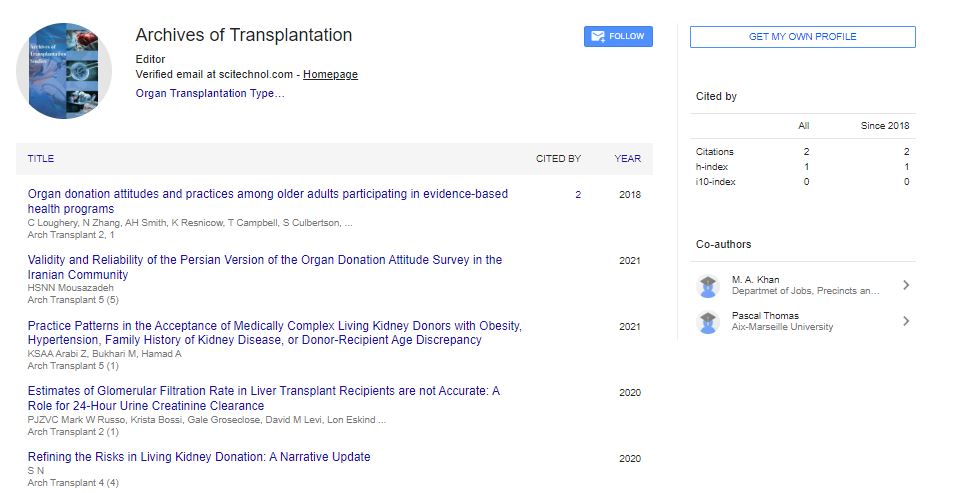Opinion Article, Arch Transplant Vol: 7 Issue: 4
Advancements in Enhancing Types and Applications of Artificial Organ
Lehou Zhang*
1Department of Ultrasound Medicine, Huazhong University of Science and Technology, Wuhan, China
*Corresponding Author: Lehou Zhang,
Department of Ultrasound Medicine,
Huazhong University of Science and Technology, Wuhan, China
E-mail: lehou_zhangh@hust22.cn
Received date: 22 November, 2023, Manuscript No. AT-24-124969;
Editor assigned date: 24 November, 2023, PreQC No AT-24-124969 (PQ);
Reviewed date: 11 December, 2023, QC No. AT-24-124969;
Revised date: 19 December, 2023, Manuscript No. AT-24-124969 (R);
Published date: 26 December, 2023, DOI: 10.4172/AT.1000151
Citation: Zhang L (2023) Advancements in Enhancing Types and Applications of Artificial Organ. Arch Transplant 7:4.
Description
Artificial organ transplantation has emerged as an advanced field in medical science, providing hope to those in need of life-saving interventions. Over the years, significant strides have been made in enhancing the types and applications of artificial organ transplantation. It delves into the evolving landscape of this transformative technology and its diverse applications. Artificial hearts have been a focal point in cardiac care. These mechanical devices mimic the pumping action of the human heart, sustaining patients awaiting heart transplants or recovering from cardiac events. Continuous studies aims to improve durability and functionality, making them viable long-term solutions.
The development of bioengineered lungs holds potential for addressing the essential shortage of donor organs. Analysts are exploring methods to construct lungs using a patient's cells, reducing the risk of rejection and increasing the pool of available organs for transplantation. Bionic limbs, controlled by neural interfaces, are transforming the lives of amputees. These artificial limbs can replicate natural movements, offering enhanced mobility and functionality. Ongoing advancements focus on improving the sensory feedback, providing users with a more intuitive experience.
Artificial devices designed to assist the functioning of the pancreas and kidneys are gaining traction. These assistive technologies are particularly beneficial for individuals with diabetes or renal failure, offering a bridge to transplantation or even serving as long-term solutions. Advancements in immunomodulation techniques aim to minimize the risk of rejection. Customized drug regimens and therapies that modulate the immune response are being explored to enhance the acceptance of artificial organs and prolong their lifespan within the recipient.
De-cellularization involves removing cellular components from donor organs, leaving behind a scaffold. This scaffold can then be recellularized with the recipient's cells, developing a personalized organ with reduced immunogenicity. This method holds promise for overcoming the challenges of organ rejection. Artificial organs serve as temporary solutions, providing vital support to patients awaiting traditional organ transplants. Devices like artificial hearts and lungs provide a lifeline, sustaining patients until a suitable donor becomes available.
Artificial organs play a pivotal role in managing chronic conditions. For example, bioengineered pancreas assist devices can help regulate blood sugar levels in individuals with diabetes, reducing their reliance on insulin and enhancing their quality of life. The field of regenerative medicine is intersecting with artificial organ transplantation. Experts are exploring ways to develop functional organs using a patient's own cells, minimizing the risk of rejection. This approach has the potential to revolutionize transplantation by eliminating the need for donor organs altogether.
Bionic limbs and other artificial organs contribute to an improved quality of life for individuals with physical disabilities. These technologies empower users to regain lost functionalities, fostering independence and reducing the impact of disabilities on daily activities. While the progress in artificial organ transplantation is remarkable, challenges persist. Issues such as biocompatibility, longterm durability, and the prevention of rejection reactions remain areas of active innovation. Additionally, ethical considerations and accessibility to these advanced technologies are important factors that require attention.
Looking ahead, the future holds exciting possibilities. The integration of artificial intelligence and machine learning in organ transplantation could enhance predictive modeling for organ matching, reducing wait times and improving outcomes. Moreover, the continued collaboration between analysts, engineers, and medical professionals is essential for pushing the boundaries of what is achievable in this dynamic field.
Conclusion
Artificial organ transplantation stands at the forefront of medical innovation, providing hope to countless individuals in need of lifesaving interventions. The evolving landscape of types and applications reflects a commitment to overcoming the limitations of traditional organ transplantation. As studies and technology continue to advance, artificial organs will play an increasingly significant role in reshaping the landscape of healthcare, providing solutions for patients and transforming the way one can approach organ failure.
 Spanish
Spanish  Chinese
Chinese  Russian
Russian  German
German  French
French  Japanese
Japanese  Portuguese
Portuguese  Hindi
Hindi 